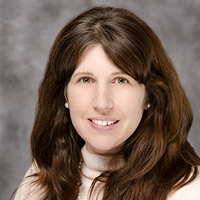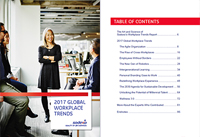Purposefully designing for the future
Interview with Rachel Permuth, Global Vice President of Research, Corporate Services at Sodexo.
 Sodexo’s 2017 Workplace Trends Report is hot off the press with 10 major trends that will impact our workplace today and in the years to come. Today we sat down with Rachel Permuth, Global Vice President of Research, Corporate Services at Sodexo, to talk about the growing expectations around experience design in the workplace.
Sodexo’s 2017 Workplace Trends Report is hot off the press with 10 major trends that will impact our workplace today and in the years to come. Today we sat down with Rachel Permuth, Global Vice President of Research, Corporate Services at Sodexo, to talk about the growing expectations around experience design in the workplace.
What exactly is experience design?
Rachel Permuth: Experience design is a term best known in the hospitality, travel and tourism sectors where people seek out different types of experiences - beyond the ordinary. In the workplace, experience design is the overall practice of designing products, services, journeys or environments with the endgame of focusing on the quality of the employee experience. It is paramount to ensure that whatever we design is also culturally relevant – in terms of geography and the type of business. It also needs a specific type of research tactic to hone in on the uniqueness of the employee.
Experience design can also extend to the environment created for visitors to the workplace – people from another geography or local clients. So our goal is to help tailor solutions that really surprise them, delight them, make them more productive and essentially make their life easier and better. The term experience design is somewhat new and a lot of people still haven’t put that hospitality lens on it yet. But at Sodexo, we pride ourselves on having a history in hospitality. So when we create an experience, we can draw on the expertise that we already have in terms of social interaction.
What does this look like in a typical workplace?
R.P.: Let’s say I have a broken light in my office. Experience design asks: how could a service make the repair process easy for me? The answer is in having a number to call or text, or an email address; getting a prompt response; being assured that the issue will be handled in a timely way; and afterward, receiving a follow-up to ensure that expectations were met.
Experience design looks at every aspect from an employee’s point of view, from the time they wake up and get into the car or use public transportation. How easy or hard is the commute? Is the parking accessible and available? Is the snow shoveled in the parking lot when they arrive? Once they are in the office, do they have a pleasant experience in the breakroom? Is the coffee high quality? Are there chairs in the area? Are they the right chairs? It’s all about different touchpoints along their journey in the work day – and even before and after – that can either be facilitated or be the cause of a great deal of stress.
What about in a less-typical office environment, such as a manufacturing plant?
R.P.: The touchpoints are the same, but the way we handle them is different. For example, take the security in a manufacturing site parking lot. Shifts often end in the middle of the night, so that presents the opportunity to create a positive experience – one with onsite parking, on-duty security guards to ensure safety, etc. Similarly, shift workers may not have traditional meal schedules because everyone eats at a different time. So the focus can center on having hot food brought to them via a kiosk, instead of building an entire café or restaurant.
How do you see this field evolving in the coming years?
R.P.: I definitely think there’s going to be a big push towards measurement and understanding the effects that experience design has on user behavior, employee behavior and outcomes. There’s also a lot of pressure to recruit the top talent and address the expectations from the millennial pool. In terms of personalization and experience customization, I’ve never seen such a high demand. And we’re not even sure yet what Gen Z is going to expect from us, so it will behoove workplace strategists to really understand individual behavior across different generations as well as cultural and industry nuances. Workplace strategists will need to add a new skill set to their repertoire. I think you’re going to see more change management, behavioral science and people1 who work in design to help craft these experiences. Overall, it needs to become a much more interdisciplinary practice, informed by all stakeholders.
There is a lot of talk about millennials in the workplace. Do their expectations for experience design differ from previous generations?
R.P.: Yes. With millennials, communication needs to be very quick, very easy; the language needs to be tailored to this generation – so information has to be given succinctly. Management needs to know when to reward and recognize individuals, and to use culturally-relevant items, such as an Uber ride. We need to consider an employee’s ability to give feedback – they have grown up with technology that gives them a feedback loop, literally at their fingertips. As a result, they feel obligated to provide feedback.
Any final thoughts on the importance of experience design in the future workplace?
R.P.: We need to think about experience design from the point of view of employees. If companies don’t invest in this area, what does it say? It says my company has thought about this and they don’t care. Creating an easier, more enjoyable work environment will motivate employees – and in turn that leads to more participation and more collaboration.


